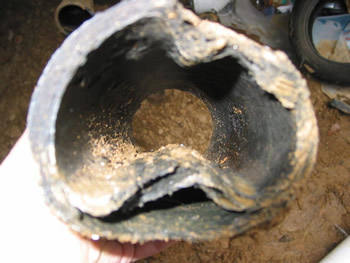Let me start by saying that I am not perfect by any means, and all real estate professionals have had their share of difficult photo situations when it comes to showing a house to its fullest potential. That being said, I have a few tips regarding photos for those who wish to sell their homes… specifically for the Main Photo which will show first on the MLS, and usually all flyers etc.
Looking through the MLS for examples of “do’s and don’ts”, I was frankly surprised to find so many “don’ts” from which to choose.
I find that the most common mistakes fall into four categories:
 ‘Shady’ Homes…
‘Shady’ Homes…
If you want potential buyers to be attracted to your home, they must at minimum be able to see it. If the time of day is just wrong, as far as shade goes, ask your agent to come later that day, or the next day to make sure that the home is looking bright and shiny in that all-important Main Photo. And if it is evening when you sign that listing agreement, ask your agent to come back when the sun is out to photograph your home! Photo editing tools, and house lighting can also help to lighten a dark photo.
 ‘Lost in the Woods’ Homes…
‘Lost in the Woods’ Homes…
Here in Lake Oswego, we are blessed with an overabundance of gorgeous greenery, and trees are revered and protected by the city and citizens alike. When you are taking a photo of your home, you want that potential buyer (who will give it a maximum of two seconds worth of attention before moving on to the next home in their Internet search) to say “Wow! Let’s look at this one honey.” So… work with every angle.
 If you have to, take a shot closer-in to the front of the property that actually shows the house, and feature more photos showing the larger area in subsequent photos (you now have the option of including 16 photos on the MLS). In the most difficult cases, short of drastically trimming the trees, another option is to give your agent a photo of the home that has been taken in winter or fall when the trees were bare of leaves so that the house is visible… and attractive to a buyer!
If you have to, take a shot closer-in to the front of the property that actually shows the house, and feature more photos showing the larger area in subsequent photos (you now have the option of including 16 photos on the MLS). In the most difficult cases, short of drastically trimming the trees, another option is to give your agent a photo of the home that has been taken in winter or fall when the trees were bare of leaves so that the house is visible… and attractive to a buyer!
 The ‘Star Garage’ Home…
The ‘Star Garage’ Home…
Now, I don’t need to tell you that there is probably a better angle for each of these homes (and no, garbage cans are not an attractant). Yes, some of our beautiful homes have garages that are prominent to the street.
 There are ways to shoot these homes that really show off the beauty of their entirety. This usually involves taking the photo from the non-garage-prominent side of the house at an angle.
There are ways to shoot these homes that really show off the beauty of their entirety. This usually involves taking the photo from the non-garage-prominent side of the house at an angle.
And though there are several more “dont’s” categories we could go over, one more that I found prevalent is the…
“Look At My Entry or Driveway” Home…




Bottom line, the Main Photo needs to be your “Showcase”. It should show off your real estate and really be a beautiful shot representing the front of your home in the best way possible. Circular driveway shots and other yard features can be highlighted after you come up with that one great, frontal shot of the house itself.
 And, last but not least, remember that your Main Photo needs to be of your house on the MLS…
And, last but not least, remember that your Main Photo needs to be of your house on the MLS…
Although you may have an incredible view of Mt. Hood, or treetops, or the valley, that Main Photo actually needs to be of your house. Please add gorgeous feature shots like this one after the Main Shot.

So…. Show off architecture ~ Present more than one shot to highlight that big, beautiful porch, etc. Or have a drawing commissioned if the season (or available angle) is just not right.
If your home is up above street level, consider climbing a ladder leaned on a streetlight pole (be careful!) to get that impossible shot of your home
But use your Main Photo wisely… it is the first (and can easily be the last) impression you make.

 You may have noticed that the market has been changing for awhile now. Many buyers are out this fall scouting for great deals (they are not hard to find!), and many sellers who are pricing and marketing appropriately are benefiting from the uptick in activity in Lake Oswego (see Ron’s blog post of Monday 9/29). It is also true that some decided in the spring and summer to spruce up their homes in anticipation of changing market conditions, and the expectation of reaping some profit from their efforts when the time comes to sell.
You may have noticed that the market has been changing for awhile now. Many buyers are out this fall scouting for great deals (they are not hard to find!), and many sellers who are pricing and marketing appropriately are benefiting from the uptick in activity in Lake Oswego (see Ron’s blog post of Monday 9/29). It is also true that some decided in the spring and summer to spruce up their homes in anticipation of changing market conditions, and the expectation of reaping some profit from their efforts when the time comes to sell.
 I have seen everything from what seems like extreme overpricing ($100,000 or more above what seems like a reasonable asking price) to modest positioning above apparent market value.
I have seen everything from what seems like extreme overpricing ($100,000 or more above what seems like a reasonable asking price) to modest positioning above apparent market value.



 According to Kelley Woodwick at Chicago Title, there is good news for sellers, in that flood insurance contracts may be transferred to new buyers at grandfathered rates and zones. Again, check the city’s new maps before June 18th to acquire information on the grandfathered areas… after the 18th, I am told that the information will most likely be removed from the website.
According to Kelley Woodwick at Chicago Title, there is good news for sellers, in that flood insurance contracts may be transferred to new buyers at grandfathered rates and zones. Again, check the city’s new maps before June 18th to acquire information on the grandfathered areas… after the 18th, I am told that the information will most likely be removed from the website.  For most of the 20th century, oil heat was the primary method of heating homes. If you own or are considering purchasing a home that was built before 1965, chances are pretty good that the house had oil heat. And chances are also pretty good that the oil tank was buried in the ground.
For most of the 20th century, oil heat was the primary method of heating homes. If you own or are considering purchasing a home that was built before 1965, chances are pretty good that the house had oil heat. And chances are also pretty good that the oil tank was buried in the ground. On a recent Broker’s Tour in Lake Oswego, my cohorts and I were discussing how important it is to include accurate information in listings, and we noted how easy it is to inadvertently choose the wrong “field” when entering data etc. I thought it might help the prospective home seller or buyer to know a little about how agents search for houses, specifically in using the basic search fields provided to them on the MLS.
On a recent Broker’s Tour in Lake Oswego, my cohorts and I were discussing how important it is to include accurate information in listings, and we noted how easy it is to inadvertently choose the wrong “field” when entering data etc. I thought it might help the prospective home seller or buyer to know a little about how agents search for houses, specifically in using the basic search fields provided to them on the MLS. And, last but not least, remember that your Main Photo needs to be of your house on the MLS…
And, last but not least, remember that your Main Photo needs to be of your house on the MLS…
 What does this mean to you? It means that if you have your home priced according to what other homes in your neighborhood have sold for, and your home is clean and in good repair, you’ll sell your home at 8.5% over what it was worth a year ago and it will happen in about 80 days.
What does this mean to you? It means that if you have your home priced according to what other homes in your neighborhood have sold for, and your home is clean and in good repair, you’ll sell your home at 8.5% over what it was worth a year ago and it will happen in about 80 days. The Fibre Conduit Company of Orangeburg, N.Y. was a major manufacturer of this kind of pipe, and with its widespread use, changed its name to the Orangeburg Pipe Co. — thus the common name of the product. If your home was built during this period, there is a good chance that you have this kind of sewer pipe lurking underground, so it is good to know what this could mean to you as either a homeowner, or someone contemplating a purchase.
The Fibre Conduit Company of Orangeburg, N.Y. was a major manufacturer of this kind of pipe, and with its widespread use, changed its name to the Orangeburg Pipe Co. — thus the common name of the product. If your home was built during this period, there is a good chance that you have this kind of sewer pipe lurking underground, so it is good to know what this could mean to you as either a homeowner, or someone contemplating a purchase.